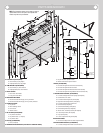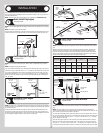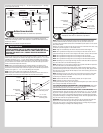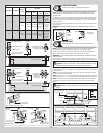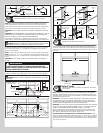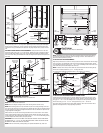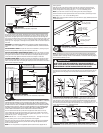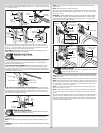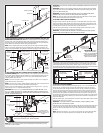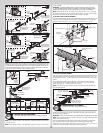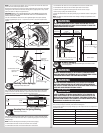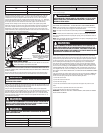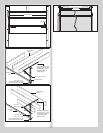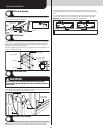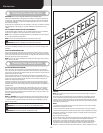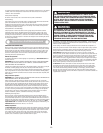
Typicall center
bracket
Vertical line
Mounting surface
Equal distance (top of door section to horizontal line)
Horizontal line
Typicall center
of end bearing
bracket
IF YOUR DOOR DID NOT COME WITH A CENTER COUPLER ASSEMBLY AND USES TOR-
SION SPRINGS LESS THAN 3-3/4” ID: Mark a vertical pencil line on the mounting surface
above the door, at the center. Align the edge of the center bracket with the vertical pencil
line and the center of the center bracket with the horizontal pencil line; this is to ensure the
torsion shaft is level between the center and end bearing brackets.
NOTE: On some single spring doors, the single spring can be longer than half the opening
width. If your spring is longer, then the center bracket must be mounted off center for the
spring to fit properly. Measure spring length to determine appropriate center bracket location.
Center bracket
bushing assembly
(1) 5/16” X 2” or (1) 5/16” x 1-5/8” Tamper-resistant lag screw
(2) 5/16” x 1-5/8”
Lag screws
Vertical
line
Mounting
surface
(3” Minimum)
Horizontal
line
Vertical
line
Mounting surface
(3” Minimum)
Horizontal
line
Center
bearing
bracket
assembly
(2) 5/16” x 1-5/8”
Lag screws
IF YOUR DOOR DID COME WITH A CENTER COUPLER ASSEMBLY AND USES 3-3/4”
ID TORSION SPRINGS: Mark a vertical pencil line on the mounting surface above the door,
at the center. Split the difference up and position the (2) center bearing brackets apart from
each other. Mark two vertical pencil lines, one for each center bearing bracket onto the
mounting surface above the door.
NOTE: If your door came with a center coupler assembly or if it utilizes 3-3/4” springs, the
springs will not share a center bracket.
NOTE: If your door has (4) springs, split the distance between the center of the door and the
end bracket on each side to locate the intermediate center brackets.
Attach each of the center bracket(s) to the mounting surface, using (2) 5/16” x 1-5/8” lag
screws and (1) 5/16” x 2” tamper-resistant lag screw.
IMPORTANT: USE A 5/16” X 1-5/8” TAMPER-RESISTANT LAG SCREW INSTEAD OF THE
5/16” X 2” TAMPER-RESISTANT LAG SCREW IF MOUNTING SURFACE IS MOUNTED OVER
MASONRY. TAMPER-RESISTANT LAG SCREW MUST BE ATTACHED THROUGH THE BOTTOM
HOLE OF THE CENTER BRACKET(S).
(1) 5/16” X 2” or (1) 5/16”
x 1-5/8” Tamper-resistant
lag screw
Vertical
line
Mounting surface
(17” Minimum)
Horizontal
line
(2) 5/16” x 1-5/8”
Lag screws
Vertical line
(2) 5/16” x 1-5/8”
Lag screws
† (2) Center bearing
brackets spaced 6” to 7”
apart from the center of
the door.
Center
of
door
†
Torsion Spring Assembly
Tools Required: 3/8” Wrench, 9/16” Wrench, Step Ladder
21
NOTE: Refer to the Package Contents and or Parts Breakdown to determine if your door
came with a coupler assembly.
IMPORTANT: RIGHT AND LEFT HAND IS ALWAYS DETERMINED FROM INSIDE THE BUILDING
LOOKING OUT.
IMPORTANT: Identify the torsion springs provided as either right hand wound (red winding
cone), which goes on the LEFT HAND SIDE or left hand wound (black winding cone), which
goes on the RIGHT HAND SIDE.
IMPORTANT: ON SINGLE SPRING APPLICATIONS, ONLY A LEFT HAND WOUND (BLACK
WINDING CONE), WHICH GOES ON THE RIGHT HAND SIDE IS REQUIRED.
NOTE: The set screws used on all torsion winding cones and cable drums are now colored
red. DO NOT identify right and left hand by the set screw color.
IF YOU DON’T HAVE A COUPLER ASSEMBLY:
Facing the inside of the door, lay the torsion shaft / torsion keyed shaft on the floor. Lay the
torsion spring with the black winding cone and the black cable drum at the right end of the
torsion shaft / torsion keyed shaft. Lay the torsion spring with the red winding cone and the
red cable drum at the left end of the torsion shaft / torsion keyed shaft.
Slide the center bracket bearing / center bracket bushing onto the torsion shaft / torsion
keyed shaft followed by the torsion springs and cable drums.
IMPORTANT: THE CENTER BRACKET BEARING / CENTER BRACKET BUSHING, TORSION
SPRINGS, AND CABLE DRUMS MUST BE POSITIONED, AS SHOWN.
Torsion shaft
Center bearing
Right hand
wound, red
winding cone
(left hand side)
Left hand wound,
black winding cone
(right hand side)
Right hand
cable drum,
black
Left hand cable
drum, red
IMPORTANT: ON SINGLE
SPRING APPLICATIONS,
ONLY A LEFT HAND WOUND
(BLACK WINDING CONE),
WHICH GOES ON THE RIGHT
HAND SIDE IS REQUIRED.
With assistance, pick up the torsion spring assembly and slide one end of the torsion shaft
/ torsion keyed shaft through one end bearing bracket. Lay the middle of the torsion shaft /
torsion keyed shaft into the center bracket. Slide the other end of the torsion shaft / torsion
keyed shaft into the other end bearing bracket. Position the torsion shaft / torsion keyed shaft
so that equal amounts of the shaft extend from each end bearing bracket.
Left hand end
bearing bracket
Equal spacing
Right hand end
bearing bracket
Torsion shaft
Center
bracket
bushing
Center bracket
IF YOU HAVE A COUPLER ASSEMBLY:
Disassemble the coupler assembly by removing the (3) 3/8” - 16 x 1-3/4” hex head screws
and the (3) 3/8”-16 nylon hex lock nuts from the coupler halves. Loosen the set screws.
Set the components aside. Facing the inside of the door, lay the (2) torsion keyed shafts on
the floor. One torsion keyed shaft on the left hand side and the other torsion keyed shaft on
the right hand side. Starting on the left hand side, lay one of the coupler halves, the center
bearing, torsion spring with the red winding cone and the red cable drum at the left end of
the torsion keyed shaft. Next on the right hand side, lay the other coupler half, center bearing,
the torsion spring with the black winding cone, and the black cable drum at the right end of
the torsion keyed shaft.
Slide the coupler halves, center bearings onto the torsion keyed shafts followed by the torsion
springs and the cable drums, as shown.
IMPORTANT: THE COUPLER HALVES, CENTER BEARINGS, TORSION SPRINGS, CABLE
DRUMS MUST BE POSITIONED, AS SHOWN.
Slide the flat edge of the couple half flush with the side edge of the torsion keyed shaft. Insert
(1) key into the slot of both the coupler half and the slot in the torsion keyed shaft. Tighten
the (2) set screws and the locking nut to secure the coupler half to the torsion keyed shaft,
as shown.
NOTE: Tighten the set screws to 14-15 ft. lbs. of torque (once set screws contact the shaft,
tighten set screws one full turn). Repeat the same process for the other coupler half.
13



